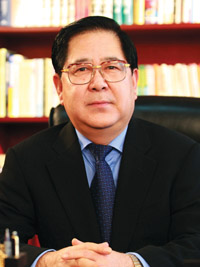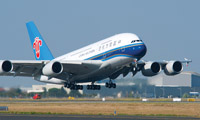Cover Story
TAKING ON THE WORLD
China Southern Airlines’ Canton Route is challenging the ‘big boys’ on lucrative routes between Australasia and Europe. But that’s only half the story, the carrier’s chairman, Si Xianmin, told TOM BALLANTYNE last month in Guangzhou, Southern China.
July 1st 2012
China Southern Airlines (CSA) carries more passengers than any other airline in Asia. It is the world’s third largest carrier by market capitalization and the sixth largest by fleet size. But CSA is not easing up. Already dominating China’s domestic market, it is taking on the world as it broadens its international reach. Read More »
 |
| 'China Southern Airlines is looking at route expansion into South America, Africa and other emerging markets to expand our hub network' |
| Si Xianmin Chairman China Southern Airlines |
When China Southern Airlines A330-200 flight, CZ303, touched down at London’s Heathrow airport on June 7 after its inaugural service from Guangzhou, the landing amounted to far more than the launch of a new route to Europe by Asia’s biggest airline.
It put in place a key element of the carrier’s plans to take a major step beyond its position as China’s leading domestic airline and cement a place in the big league of international operators.
Guangzhou-London was only half the story. Already operating 42 weekly flights from China’s third largest city to five Australasian destinations – Sydney, Melbourne, Brisbane, Perth and Auckland - for CSA this completed a vital piece of network strategy.
The new Canton Route linked Australia and New Zealand with Europe through the carrier’s southern Chinese hub and, in effect, marked a declaration of war against the big boys who have dominated traffic flows along the traditional Kangaroo Route to Europe through Singapore and, in more recent times, Middle East operators through the Gulf.
There is no mistaking the intentions of CSA’s group chairman and president, Si Xianmin: the likes of Qantas Airways, Singapore Airlines and Emirates Airline, with their A380s flying these routes, have a new challenge on their hands.
The route from Sydney to London via Singapore, he pointed out, was 17,152 kilometres. Through Dubai it is even further, some 17,519 kms. By way of Guangzhou, it is 16,995 kms.
“From a sheer geography standpoint, Guangzhou is the most logical transit point with the shortest transit distance. Based in Guangzhou, a city with a millennium of ancient history, our exclusive Canton Route will be a bridge between Europe and Australasia,” said Si.
“The successful opening of this Guangzhou-London route is an important part of China Southern Airlines’ global expansion strategy. It will significantly enhance China Southern’s route network and strengthen the importance of Guangzhou aviation hub,” said Si, who has been chairman since January, 2009.
If his major rivals think CSA’s current A330 service doesn’t amount to much of a challenge against the attraction of their big A380s, this will change.
 |
| China Southern Airlines: the first Mainland airline to fly the A380 |
CSA has taken delivery of three of five A380s it ordered. The fourth will arrive in September and the fifth early next year. The first A380s to be flown by a Chinese airline, they are operating on domestic routes so crew can “gain necessary expertise for its operation”.
While Si won’t say when, he strongly hints the airline’s A380s will be used on the Canton route. “We have just launched the London route. It takes time to nurture the air travel market in Europe. After we have spent time building up the market it is workable to put the super jumbo on the route,” he said.
A tough executive, but with a quick sense of humour, Si has already overcome the shortage of slots at London Heathrow. Currently able to operate only three flights weekly to London, that will change later this year.
“It’s extremely difficult to get slots at London Heathrow airport. However, from this winter (October or November) onwards London Heathrow has made relevant arrangements to guarantee China Southern daily services,” said Si.
“We have put a lot of hard work into obtaining the slots and that will be of significance to our strategic planning and strategic development.”
In Europe, CSA flies to Paris and Amsterdam and has the ability to offer a significant European network across the continent. “With the dense route network of SkyTeam in Europe, arriving passengers can easily transfer to Milan, Berlin, Frankfurt and other European cities,” said Si.
“China Southern has also established close co-operation with British Airways and other airlines in London. Arriving passengers from Guangzhou can quickly transfer to BA flights to Aberdeen, Edinburgh, Manchester and other cities within the United Kingdom.”
|
Airlines in the
China Southern Airlines Group China Southern Airlines; Xiamen Airlines; Guangxi Airlines; Zhuhai Airlines; Guizhou Airlines; Shantou Airlines; Chongqing Airlines |
While Australasia is a critical part of expansion strategy – it aims to increase services there to 55 return weekly flights by 2015 – it is only one element of the carrier’s global plans. Si said flights to Southeast Asia would continue to increase in frequency.
“China Southern Airlines is looking at route expansion into South America, Africa and other emerging markets to expand our hub network. The broader vision of the Canton Route is to build Guangzhou as a global, comprehensive, long-haul aviation hub,” he added.
There is plenty of room to grow. CSA’s international operations account for only 18.4% of its ASKs and the carrier wants to increase this substantially. It may already be a big airline, but international expansion only began in earnest in 2006, when it commenced promoting twin hubs at Guangzhou and Beijing.
In 2007, CSA was accepted into SkyTeam and became the first Chinese airline to join a global alliance. It then set about accelerating the “pace of its internationalization”.
Today, it has a varied fleet of more than 450 passenger aircraft and freighters, including B747s, B777s, B757s, B737s, A380s, A330s, A320s, A321s and A319s. It has 190 aircraft on order, to be delivered between 2012 and 2016, including 10 B787 Dreamliners that will begin arriving later this year. During 2012, it expects to take delivery of 57 aircraft.
That strategy won’t be impacted by the ongoing fight between China and Europe over the latter’s carbon emissions scheme, which has seen Beijing order Chinese carriers not to participate in it. Government authorities have suspended the purchase of 55 Airbus jets, including 45 A330s and 10 A380s worth $14 billion.
Si insists its Airbus orders are not affected. As well as the two A380s still to come there are nine A330s due for delivery, three arriving this year, three in 2013 and three in 2014. “Decisions on plane orders are dictated by China Southern development strategy and market demand so we will not cancel our orders,” he said.
 |
| China Southern has been guaranteed slots for a daily London service into Heathrow from later this year and has established close cooperation with British Airways |
CSA has its own cargo subsidiary, China Southern Cargo, which operates two B747-400F freighters and six B777Fs from Guangzhou and Shanghai’s Pudong airport to destinations in North America, Europe, and Australia.
Established in 1988 following Beijing’s decision to split the operating divisions of the Civil Aviation Administration of China (CAAC) into separate regional airlines, China Southern attracted six million passengers in 1991 on 38 Boeing jets. It served 90 domestic and 17 international destinations, mostly in Asia.
Last year, it carried 80 million passengers on a route network that spanned 150 destinations in China and 41 overseas. It now has 1,930 daily flights to 191 destinations in 39 countries.
In 2011, it expanded its international network by 27%, opening key markets, including Perth, Tbilsi (Georgia) and Istanbul. But the most rapid growth occurred in Australasia, where it increased flights from seven to 42 weekly.
But fleet and network expansion come at a cost. CSA had capital commitments of $10.2 billion at the end of 2011, mostly related to the acquisition of aircraft and flight equipment.
With $11.9 billion of debt at the end of last year - its ratio of net debt to total equity was 201% in 2011, compared with 211% in 2010. Last month its parent, state-owned China Southern Air Holding Company, announced CSA would receive a cash injection of up to $314 million to lower its debt amid global economic uncertainty.
The carrier will place 465.12 million new A shares at 4.3 yuan (67 US cents) each with its parent in exchange for the capital, it said in a statement to the Hong Kong Stock Exchange.
 |
| 'From a sheer geography standpoint, Guangzhou is the most logical transit point with the shortest transit distance' |
| Si Xianmin |
CSA will use the money to repay bank loans and for working capital. The injection follows two similar fund raising exercises, in 2009 and 2010, totalling around $2 billion, after it suffered heavy losses in 2008 during the financial crisis.
CSA reported a 12% fall in 2011 net profit to $809 million and has told the Hong Kong Stock Exchange it expects net profit in the first quarter of 2012 to have fallen by more than 50% from a year earlier due to a slowing Chinese economy, rising jet fuel prices and a decrease in foreign exchange gains caused by a slowdown in the appreciation of the yuan against the U.S. dollar.
“The U.S. economy has just started to recover, but we haven’t seen any recovery in the Euro zone,” said Si.
“However, in general, the aviation industry in the Asia-Pacific market is maintaining its momentum for growth. In China, for example, although the growth rate of the industry has slowed down, it is still growing. For the last nine months the growth rates have remained at 8%.”
But he said cutting down operating costs were particularly difficult because of the fuel price. “Fuel costs for CSA accounts for roughly 43% of operating costs. So we are doing our best to find or explore new ways to save costs and keep operating costs at a reasonable level,” said the chairman.
“Against the not so optimistic global economic outlook, and taking the high operating costs into consideration, we need to be very cautious when it comes to launching long-range international routes.”
Si said CSA was planning its strategic developments based on the current global situation, but wants to be ready to develop quickly when the global markets recover.
Rivals who believe Chinese airlines still have a way to go to match their Western rivals in service standards need to think again. The gap is contracting rapidly. CSA’s cabin design in its new A380s and A330s is as good as offerings from other major operators.
Si said inflight entertainment and other hardware and software in older planes was being upgraded. Last year, the airline was awarded a four-star ranking by Skytrax.
It is also well into a roll-out of priority services, part of a new customer service programme offering uniform VIP treatment to premium SkyTeam members wherever they are travelling across the alliance.
China Southern became the first SkyTeam member in China to add the service to its Guangzhou and Beijing hubs (Shanghai-based China Eastern Airlines is also in Skyteam). The programme provides Elite Plus and Gold Card members access to VIP services at each airport, including CSA’s modern and stylish new business class lounge at Guangzhou’s Baiyun Airport.
The SkyPriority service provides priority check-in, boarding, transfers and ticketing and baggage delivery. All SkyTeam member airlines are expected to roll out the service in more than 1,000 airports around the world, including 164 used by China Southern, by the end of the year.
Once a major concern in China’s aviation industry, safety standards are now among the best in the world. By December last year, CSA had accumulated nearly nine million hours of safe flight operations and carried close to 600 million passengers without incident.
Si is also working hard to resolve an issue that puts some restraint on Guangzhou’s ability to attract increasing numbers of transit passengers. At the moment, unlike other big transit hubs like Singapore and Dubai, foreign visitors can only stop for 24 hours without a visa.
“We have been working hand-in-hand with Baiyun airport and the local government to prolong the visa waiver. Our goal is for the granting of a 72-hour visa-free period for our transit passengers, or at least 48 hours,” said Si.
“I think this goal can be achieved through our joint efforts, but I cannot give you a fixed time frame because it is all up to central government.”
If successful it will make Guangzhou far more attractive as a stopover hub for passengers travelling between Australasia, Asia and Europe.
Closer to home, CSA may be facing another challenge, the arrival on the scene of a new low-cost carrier (LCC), Jetstar Hong Kong, a 50/50 joint venture between Qantas Airways and China Eastern Airlines. The LCC has still to win the necessary regulatory approval.
However, Jetstar Hong Kong has made it clear flights into mainland China will be a major focus of its operations. Si is unperturbed.
“We are well aware of this joint venture,” he said. “Different airlines have different choices for their strategic development. At this stage China Southern doesn’t have any plans to co-operate with another airline to set up an LCC.”
As for Qantas’ efforts to break into the Chinese market, he pointed out the Australian carrier once flew to Beijing, but not any more.
“No matter what strategy Qantas is going to adopt for their future development in China, we wish them all the best!” he said.